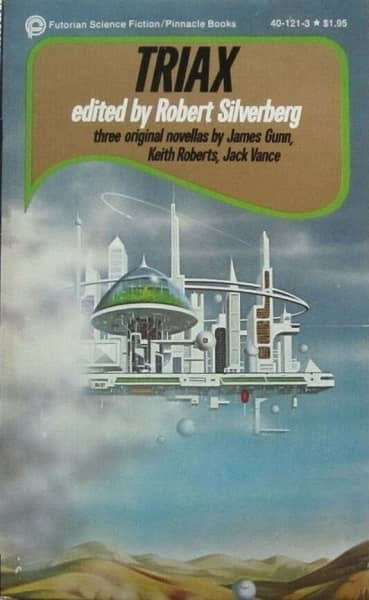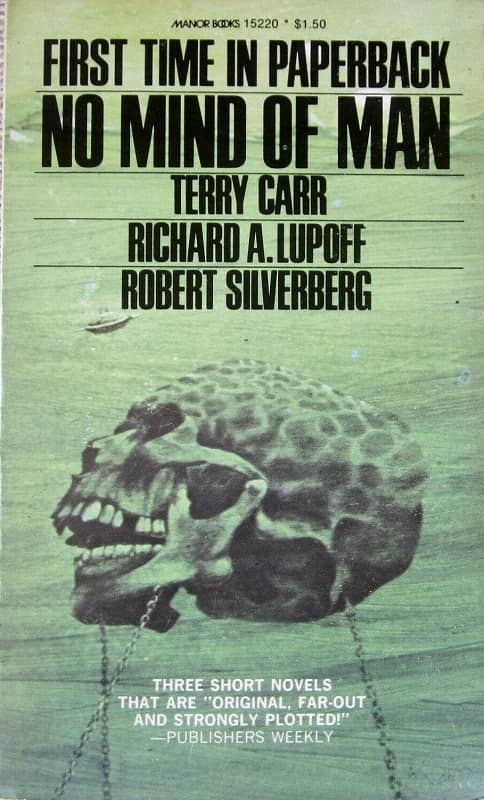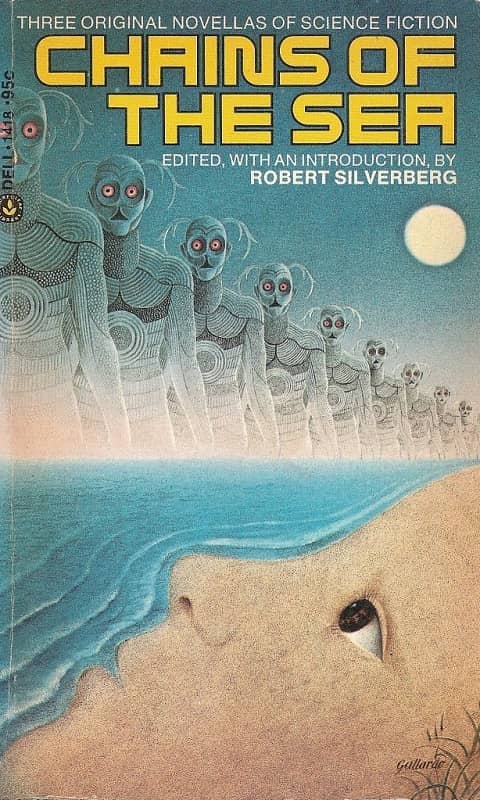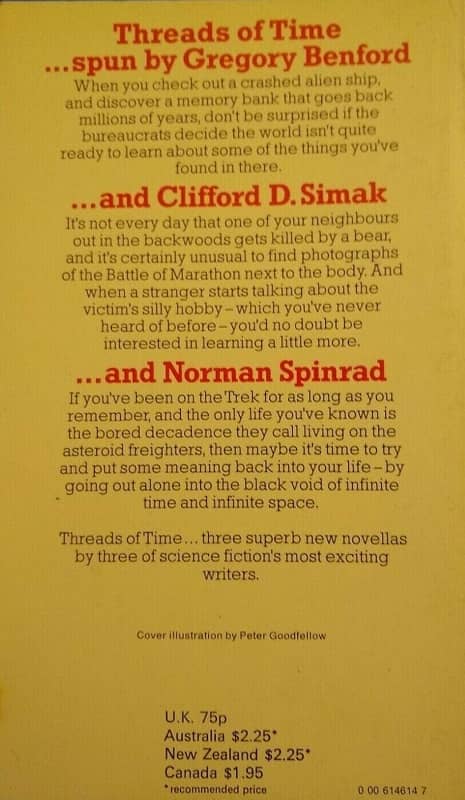A Master With a Keen Eye: Robert Silverberg’s Original Anthologies of the 1970s
 |
 |
 |
 |
 |
 |
 |
 |
 |
Paperback editions of Silverberg 70s original anthologies. Published by (left to right, from top left):
Dell, Manor Books, Dell, Manor Books, Dell, Dell, Fontana, Warner Books, Pinnacle
In 1966 Robert Silverberg published his first anthology, an unassuming volume titled Earthmen and Strangers from staid New York press Duell, Sloan and Pearce, known mostly for the infamous U.S. Camera 1941 annual that was banned in Boston for daring to include nudes. Earthmen and Strangers was hugely successful, remaining in print for an astonishing two decades, with paperback reprints from Dell, Manor Books, and Bart Books, and Silverberg was off to the races as an editor. Over the next five decades he published dozens of science fiction anthologies, including a handful of bestsellers like the seminal Legends (1998) and its science-fictional sequel Far Horizons (1999).
Beginning in the late 60s and all through the 70s Silverberg produced a steady stream of original anthologies, most of which had a signature format: each contained three novellas from the biggest names in the industry, including major award nominees by James Blish, Gordon R. Dickson, Jack Vance, Clifford D. Simak, Norman Spinrad, Gene Wolfe, Ursula K. Le Guin, and James Tiptree, Jr. — plus novellas by Roger Zelazny, R. A. Lafferty, Harry Harrison, Alexei Panshin, Poul Anderson, Larry Niven, John Brunner, George Alec Effinger, Gardner Dozois, Gregory Benford, Joan D. Vinge, Vonda N. McIntyre, Keith Roberts, James Gunn, Phyllis Gotlieb, and many others.
Like Terry Carr’s Universe, Damon Knight’s Orbit, and Silverberg’s own New Dimensions, these anthologies were prestige fiction markets, appearing in hardcover and distributed to libraries, and getting a lot of attention when awards season rolled around. As a result they attracted a lot of talent. Silverberg was a master with a keen eye for emerging talent, and an uncanny ability to coax top-notch work of out his contributors. The books still make entertaining reading today.
[Click on the images for more prestigious versions.]
 |
 |
 |
 |
Three for Tomorrow (Dell, 1970) and Four Futures (Manor Books, 1976 ). Covers: uncredited, and Bruce Pennington
Silverberg produced eleven original anthologies in this format. All but one were originally published in hardcover.
Here’s the complete list:
Three for Tomorrow (1969)
Four Futures (1971)
The Day the Sun Stood Still (1972)
No Mind of Man (1973)
Three Trips in Time and Space (1973)
Chains of the Sea (1973)
Threads of Time (1974)
The New Atlantis (1975)
The Crystal Ship (1976)
Triax (1977)
The Edge of Space (1979)
The last volume on the list, The Edge of Space, was the first to not have a paperback reprint, and the first to feature chiefly new writers. It effectively brought the series to an end.
In a way, the timing was fortuitous. The next year Silverberg’s career took off with the Hugo-nominated Lord Valentine’s Castle in 1980; it became the opening volume in his career-defining Majipoor series.
He handed his New Dimensions anthology series off to his protégé Marta Randall that same year, and thereafter focused on his own novels, and prestigious reprint anthologies like The Arbor House Treasuries, (which we discussed last month), The Fantasy Hall of Fame (1983), and the bestselling Legends volumes.
 |
 |
 |
 |
The Day the Sun Stood Still (Dell, 1975) and No Mind of Man (Manor Books, 1973). Covers: Andy Lackow, uncredited
Why focus on novellas? I’ve never heard a definitive answer, but it’s not hard to guess. Silverberg had a strict word limit for his New Dimension annual anthology series, and a great many authors clamoring for a slot. He also had a well-known fondness for longer SF, but since he was tightly constrained on how much he could buy, I expect these standalone anthologies began as a way to give him an outlet for novella-length fiction.
Other than the three-novella format, these books didn’t superficially have a lot in common. They appeared from a variety of publishers (chiefly Meredith Press, Hawthorn Books, and Thomas Nelson), and there was no attempt to give them a consistent look. Silverberg wasn’t even always credited as editor — The Day the Sun Stood Still doesn’t list an editor, although multiple sources (including ISFDB) finger him as the man at the helm. Only one volume, 4 Futures, contained more than three stories.
A few books had loose themes, like all-woman volume The Crystal Ship, which was marketed as a landmark of diversity (even featuring a quote to that effect from Silverberg on the back cover), but most were likely thematic accidents.
All but one (Triax) originally appeared in hardcover. Most were reprinted in paperback in the US, with the exception of Threads of Time and The Edge of Space. A handful also had UK paperback reprints.
Here’s the complete table of contents for all eleven volumes.
Three For Tomorrow (1969)
Published in hardcover by Meredith Press, August 1969
Paperback reprint: Dell, 188 pages, $0.75, August 1970 — cover uncredited
Introduction by Robert Silverberg
Foreword by Arthur C. Clarke
“How It Was When the Past Went Away” by Robert Silverberg
“The Eve of RUMOKO” by Roger Zelazny
“We All Die Naked” by James Blish — Hugo nominee
Four Futures (1971)
Published in hardcover by Hawthorn Books, October 1971
Paperback reprint: Manor Books, 206 pages, $1.25, October 1976 — cover by Bruce Pennington
Four short novels based on themes by Isaac Asimov
Foreword: Four Themes for Four Futures, by Isaac Asimov
“Ishmael Into the Barrens” by R. A. Lafferty
“Brave Newer World” by Harry Harrison
“How Can We Sink When We Can Fly?” by Alexei Panshin
“Going” by Robert Silverberg
 |
 |
 |
 |
Three Trips in Time and Space and Chains of the Sea (both Dell, 1974). Covers: Paul Lehr, Gervasio Gallardo
The Day the Sun Stood Still (1972)
Published in hardcover by Thomas Nelson, May 1972
Paperback reprint: Dell Laurel-Leaf, 221 pages, $0.75, October 1975 — cover by Andy Lackow
Foreword by Lester del Rey
Introduction (uncredited)
“Thomas the Proclaimer” by Robert Silverberg
“A Chapter of Revelation” by Poul Anderson
“Things Which Are Caesar’s” by Gordon R. Dickson — Locus Award nominee, Best Novella
No Mind of Man (1973)
Published in hardcover by Hawthorn Books, 1973
Paperback reprint: Manor Books, 190 pages, $1.50, 1973 — cover uncredited
Foreword (uncredited)
“The Winds at Starmont” by Terry Carr
“The Partridge Project” by Richard A. Lupoff
“This Is the Road” by Robert Silverberg
Three Trips in Time and Space (1973)
Published in hardcover by Hawthorn Books, 1973
Paperback reprint: Dell, 235 pages, $0.95, April 1974– cover by Paul Lehr
Foreword by Robert Silverberg
Introduction (uncredited)
“Flash Crowd” by Larry Niven
“You’ll Take the High Road” by John Brunner
“Rumfuddle” by Jack Vance — Locus Award nominee, Best Novella
Chains of the Sea (1973)
Published in hardcover by Thomas Nelson, September 1973
Paperback reprint: Dell Laurel-Leaf, 208 pages, $0.95, November 1974 — cover by Gervasio Gallardo
Introduction by Robert Silverberg
“And Us, Too, I Guess” by George Alec Effinger
“Chains of the Sea” by Gardner Dozois
“The Shrine of Sebastian” by Gordon Eklund
 |
 |
 |
 |
Threads of Time (Fontana, 1977) and The New Atlantis (Warner Books, 1978). Covers: Peter Goodfellow, Lou Feck
Threads of Time (1974)
Published in hardcover by Thomas Nelson, 1974
Paperback reprint: Fontana, 207 pages, £0.75, October 1977 — cover by Peter Goodfellow
Introduction by Robert Silverberg
“Threads of Time” by Gregory Benford
“The Marathon Photograph” by Clifford D. Simak — Locus Award nominee, Best Novella
“Riding the Torch” by Norman Spinrad — Hugo and Locus Award nominee, Best Novella
The New Atlantis (1975)
Published in hardcover by Hawthorn Books, 1975
Paperback reprint: Warner Books, 190 pages, $1.75, November 1978 — cover by Lou Feck
Introduction by Robert Silverberg
“Silhouette” by Gene Wolfe — Locus Award nominee, Best Novella
“The New Atlantis” by Ursula K. Le Guin — Hugo and Nebula nominee, Locus Award winner
“A Momentary Taste of Being” by James Tiptree, Jr. — Nebula and Locus nominee
 |
 |
 |
 |
The Crystal Ship (Pocket Books, 1977) and Triax (Pinnacle, 1977). Covers: Norman Adams, Randy Weidner
The Crystal Ship (1976)
Published in hardcover by Thomas Nelson, September 1976
Paperback reprint: Pocket Books, 188 pages, $1.50, October 1977 — cover by Norman Adams
Introduction by Robert Silverberg
“The Crystal Ship” by Joan D. Vinge
“Megan’s World” by Marta Randall
“Screwtop” by Vonda N. McIntyre
Triax (1977)
No hardcover edition
Paperback: Pinnacle Books, 222 pages, $1.95, December 1977 — cover by Randy Weidner
Introduction by Robert Silverberg
“Molly Zero” by Keith Roberts
“If I Forget Thee” by James Gunn
“Freitzke’s Turn” by Jack Vance
The Edge of Space hardcover edition (Elsevier/Nelson Books, 1979). Wraparound cover by Freff
The Edge of Space (1979)
Published in hardcover by Elsevier/Nelson Books, June 1979
224 pages, $8.95 — cover by Freff
Introduction by Robert Silverberg
“The King’s Dogs” by Phyllis Gotlieb
“In the Blood” by Glenn Chang
“Acts of Love” by Mark J. McGarry
Eleven (roughly) annual anthologies is a magnificent run. The first few enjoyed multiple reprints, but by the end of the 70s, the gas was out of the tank. The Edge of Space was the first to fail to get a paperback reprint; that was likely the death-knell for the series. There were no further volumes.
Only a handful of the books were reprinted in the 80s, and (as far as I know) none have digital editions. But they’re all easy to find. I consider them highly collectible, but none cost more than a modern paperback (even most of the hardcover editions.)
Most of the stories are still a treat for modern readers. Here’s an excerpt from Joachim Boaz’s review of The Crystal Ship at SF Ruminations.
All three of the novellas feature impressive female protagonists and narratives that subvert many of SF’s traditional clichés. All three protagonists are outcasts, striving against worlds characterized in turn by decadence, colonialism, and sadistic prison systems. Tarawassie in Vinge’s “The Crystal Ship” is cast in the vein of Alvin in Clarke’s The City and the Stars (1956). She takes on the mantel of “the one who knows how the world really is.” The eponymous heroine of Randall’s “Megan’s World” is shunned by her fellow humankind due to her mechanical and strangely colored body. She is accepted by the natives of a soon to be exploited planet and feels compelled to fight, in the final confrontation, against her own. It takes all mental and physical strength of Kylis in McIntyre’s “Screwtop” — imprisoned for minor infractions including “stealing passage” on a spaceship — to not succumb the hellish environment of the world and the sinister whims of a particularly disturbed guard…
“Screwtop” Vonda N. McIntyre… is by far the most satisfying and evocative novella in the collection. Kylis, a spaceport “rat” who spent her childhood spaceports stowing aboard ships, is captured for stealing passage and is imprisoned on the planet Redsun. A perpetually hot planet filled with strange parasites, fern plants, and volcanoes, Redun is powered by some form of geothermal energy (how exactly this works is not altogether clear). Kylis spends her day working with other prisoners removing vegetation and drilling into the planet’s crust. She encounters two disparate characters who become her friends: Jason, an writer, arrested and imprisoned for vagrancy; and a tetraparental, i.e. a designed super intelligent individual culled from the DNA of four parents, named Gryf. However, the prison guard named Lizard is commanded to force Gryf to return to the life he escaped and uses Kylis affection for Gryf and Jason as leverage.
There are indications throughout of non-traditional relationships–for example, group living and non-monogamous relationships such as Kylis, Gryf, and Jason. McIntyre’s avoids info dumps and only carefully reveals each character’s backstory. The narrative is well-told and ultimately, downright heartrending…
Highly recommended.
These books are prime examples of the cornucopia of inexpensive riches available to science fiction collectors. If you find one or two in your travels, treat yourself to a purchase. I think you’ll be surprised by what you find.
Our recent coverage of Robert Silverberg includes:
A Master With a Keen Eye: Robert Silverberg’s Original Anthologies of the 1970s
Vintage Treasures: The Arbor House Treasury of Short Science Fiction Novels edited by Robert Silverberg and Martin H. Greenberg
A Hearty Library of Genre Fiction: The Arbor House Treasuries
Vintage Treasures: The Best of Robert Silverberg
Voyagers: Twelve Journeys Through Time and Space
Up and Down Again: Robert Silverberg’s Up the Line, by Mark R. Kelly
Vintage Treasures: To Open the Sky
Vintage Treasures: The Stochastic Man
Vintage Treasures: Dark Stars edited by Robert Silverberg
A Sampling from an SF Grandmaster: The Silverberg Collections from Three Rooms Press
The Art of Author Branding: The Ace Robert Silverberg
A Fascinating, Ordinary 1950s SF Novel: Robert Silverberg’s Collision Course by Mark R. Kelly
Oz Reviews The Book of Skulls by Robert Silverberg by Nick Ozment
First-Person Singularities by Robert Silverberg
Robert Silverberg’s Tales of Majipoor
Are the days of the full-time novelist numbered? by Robert Silverberg
See all my recent long-form articles in the Editor’s Blog.

To think I have not read one of these! And i thought i had made great strides in my anthology backlog. Lovely cover art all around, would be a coin toss between Chains of the Sea and three For Tomorrow for my favourite. I quite fancy how these old stalwarts were authors and anthologists. Often collection each others work. I would need to check but pretty sure Harrison published a Silverberg in Nova.
There was an era of interesting anthology names. I too have some, like Five from Out There, Seven Phantasms etc.
> I quite fancy how these old stalwarts were authors and anthologists. Often collection each others work.
Tony — interesting point. I don’t see that Silverberg published anything by Damon Knight in his novella anthology series (though I’d be astonished if he didn’t buy something from him for NEW DIMENSIONS). But here he does present work by fellow editors Terry Carr and Harry Harrison.
At least from a distance, American science fiction does seem like a small, friendly community. (Once you get close enough, of course, you start to learn about the simmering feuds and rivalries…. just like any other close-knit family!). 🙂
John – I performed a scan of my modest anthology collection. I guessed Harrison right, Nova 1. The only other one i spotted was Rare Science Fiction edited by Ivan Howard, Belmont 1959. (quick Freeze) Silverberg seems to have been left off by Judith Merill (I have a number of her anthologies), Star, Galaxy Reader, Orbit, New Worlds, Hall of Fame, New Writings, Nebula Award etc.
I read many of these as they came out, and they were consistently entertaining. As you note, they published some excellent stuff. THE NEW ATLANTIS is probably the high point — that is truly a remarkable trio of novellas. I remember even such a minor entry as TRIAX with fondness, simply because I so love the last line of Vance’s otherwise middling “Frietzke’s Turn”.
You are making a case with your coverage of Silverberg for a re-evaluation of his editing career. He tends to get good notice for NEW DIMENSIONS, but beyond that no one much thinks of him as an editor, I suppose partly because he never edited a magazine, and never was a book acquisitions editor. All the other most famous editors fit one or another of those categories (except maybe Groff Conklin), right?
But given his original anthologies — NEW DIMENSION, these “Three Novella” collections, and also the revised UNIVERSE that followed Carr’s death, plus the underrated Elwood collaboration, EPOCH — and also his exceptional reprint work — the prestige anthologies you mention, plus the Alpha series, and many other examples — given his work in both those areas, I say, he has to be considered one of the field’s editorial giants.
> You are making a case with your coverage of Silverberg for a re-evaluation of his editing career.
Believe it or not, this long-simmering article came about as I was working on a much longer look at Silverberg’s reprint anthologies, of which there are MANY (many many). I was looking for ways to categorize them and I noticed that he had these 11 novella books, which seemed like they deserved a separate article.
I do believe that, like Asimov, one of Silverberg’s great contributions to the field was as a science fiction popularist. His anthologies were all over school libraries when I was growing up, and they were some of the first SF books I read (and DEFINITELY some of the first I remember.). He brought many young readers into the fold.
I still want to do that longer look at his reprint books, because I still remember so many of them fondly.
> All the other most famous editors fit one or another of those categories (except maybe Groff Conklin), right?
All except maybe Marty Greenberg, Damon Knight, and Isaac Asimov?
Ahh, Marty Greenberg. Yes, he counts. I suppose Asimov too but he — and Greenberg too I guess — always worked with a collaborator.
Not true! Asimov edited some of my all time favorite SF anthologies all on his own, including:
Tomorrow’s Children (1966)
Where Do We Go From Here? (1971)
Nebula Award Stories 8 (1973)
Before the Golden Age (1974)
The Hugo Winners, Volumes 1, 2, 3, 4, and 5
and a smattering more. His early anthologies (like WHERE DO WE GO FROM HERE) were top sellers, and remained in print for many years.
That laid the groundwork for the massive literary-industrial complex of his later years, where he reliably averaged about 10 anthologies a year in partnership with Marty Greenberg and Charles Waugh.
Fair points!
I would argue, though, that only SIlverberg of this list can be called a great EDITOR. The others were more in the line of anthologists. Except Damon Knight — but he DID edit two magazines (Worlds Beyond, and If) — in both cases only a few issues. (3 for Worlds Beyond, but those featured important stories by Jack Vance and William Tenn and Judith Merril, and 3 for If, just before it got sold to Galaxy’s publisher. At If he published Cordwainer Smith and David Bunch among others … he was never a bad editor.)
Incidentally Worlds Beyond was published by Hillman Periodicals, which was the publisher of THE DYING EARTH, and that may have something to do with why the December 1950 Worlds Beyond featured a Dying Earth story — presumably a reprint as the book was also published in 1950.
Anyway, good catch on Asimov and Greenberg. I would just say that for all their virtues, they could not be called “great” editors. (There’s a better argument for Conklin maybe … What would the late lamented Bud Webster say?)
One thing I JUST noticed — Bob repeated almost none of the authors on his list (except Jack Vance, who appeared twice, and himself).
Maybe these books weren’t so much NEW DIMENSIONS overflow as they were a long-running project to publish novellas by as many major writers as he could.
The text on the back of Three For Tomorrow sounds like…today.
I remember seeing some of these, but never bought any, I just wasn’t – still am not – much of a Silverberg fan. Yet I may have done myself a disservice by not getting the other novellas in them.
> The text on the back of Three For Tomorrow sounds like…today.
Distressingly, yes it does.
> I remember seeing some of these, but never bought any, I just wasn’t –
> still am not – much of a Silverberg fan. Yet I may have done myself a
> disservice by not getting the other novellas in them.
There’s a lot of great work in these books. At Rich notes above, the one to start with is probably THE NEW ATLANTIS, although I just recently bought THE CRYSTAL SHIP and am enjoying it so far.